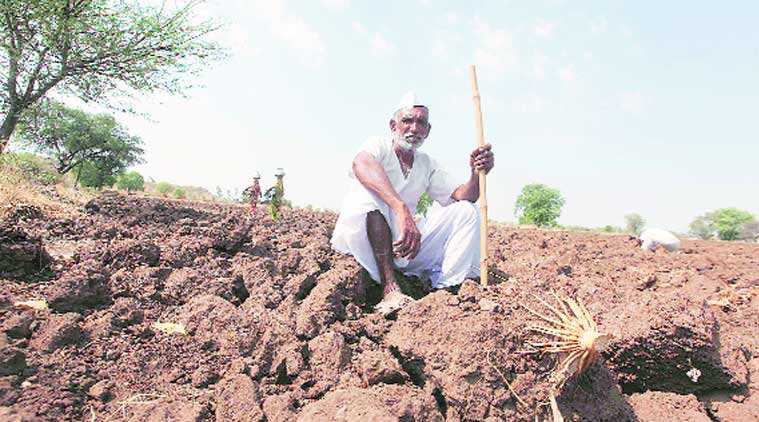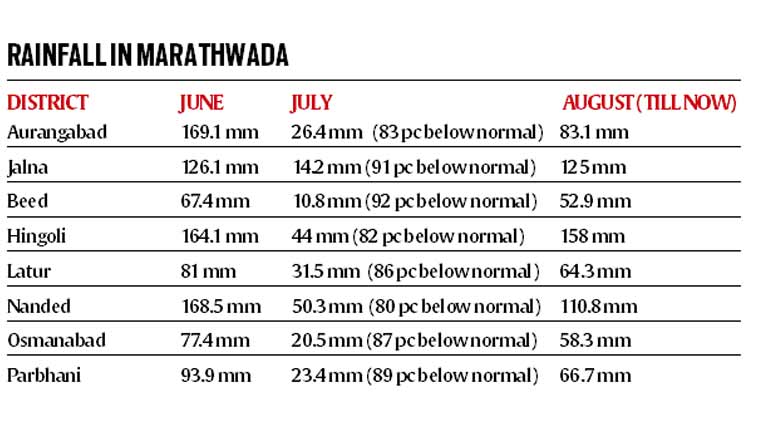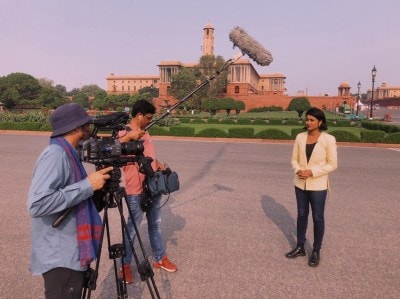- India
- International
Rains elusive, Marathwada stares at grave farm crisis
Departments to meet over the next couple of days to take decisions on relief.
 While rainfall deficit in Marathwada as of Wednesday was 47 per cent, compared to Vidarbha’s 7 per cent, Latur, Beed and Parbhani have received between 61 and 65 per cent less rain than normal.
While rainfall deficit in Marathwada as of Wednesday was 47 per cent, compared to Vidarbha’s 7 per cent, Latur, Beed and Parbhani have received between 61 and 65 per cent less rain than normal.The Marathwada region of Maharashtra is heading for a near certain agricultural drought, with the possibility of a hydrological drought looming large too. Senior state government and meteorological department officials said this, raising the spectre of a grave farm crisis in eight districts of the region.
While rainfall deficit in Marathwada as of Wednesday was 47 per cent, compared to Vidarbha’s 7 per cent, Latur, Beed and Parbhani have received between 61 and 65 per cent less rain than normal.
For the government, the worse news is that all eight districts of Marathwada have received record low rainfall in July, the crucial month for Kharif sowing. The backward district of Beed received only 10.8 mm average rainfall through the month of July, while Jalna received 14.2 mm, Osmanabad 20.5 mm and Parbhani 23.4 mm. The other four districts of Marathwada fared only marginally better, with Nanded receiving average 50.3 mm in July, Latur 31.5 mm, Hingoli 44 mm and Aurangabad 26.4 mm.
[related-post]
While Met department and state government officials were unable to immediately state if these were historical lows for July, an analysis of data for the last five years shows the previous lowest July rainfall in Marathwada was in Parbhani last July, and even that was 77.8 mm, three times the precipitation this July. Nanded, Hingoli, Beed and Jalna received between 82 and 99 mm in July last year, significantly lower than the same month in previous years.
Its agro-economy already crushed by back-to-back drought and recurrent hailstorms, the Maharashtra government’s various departments will meet over the next couple of days to arrive at quick decisions on relief to be provided to the arid region. “The government has received a report from the Aurangabad divisional commissioner regarding the gravity of multiple challenges in Marathwada, including drinking water, a near-total failure of the Kharif crop in these eight districts and the impending water/fodder crisis for livestock,” said an official of the government’s relief and rehabilitation department. “In two days, we expect decisions on releasing water from Jayakwadi dam downstream for drinking purposes only, on additional decision-making powers to be given to the Aurangabad divisional commissioner and more,” the official added.

The India Meteorological Department’s Deputy Director General K S Hosalikar, in charge of the western region, admitted that the situation looked “very grave” in Marathwada. While more rains are predicted in coming weeks, it is highly unlikely that the huge deficits would be bridged. “Averages may go up, but farmers require timely rains, so we can say agriculture in the Marathwada region is in bad shape,” he said.
Deputy Secretary (Relief and Rehabilitation) T B Survase said the resowing or second sowing season for Marathwada also failed owing to poor rains. “We will try to bring the Kharif sowing area into the Rabi season’s sowing area,” he said, though this will still mean huge losses for a majority of villages in the region.
Cloud seeding operations are currently frantically under way, with an Aurangabad-based radar focusing mostly on Marathwada, along with the periphery of Nashik and parts of Satara and Sangli that are in the rain shadow region. Another official from the relief and rehabilitation department overseeing the operation said cloud seeding had been on for seven days, and while the first three days saw positive results and some welcome rain, there were currently no clouds at all over the central Maharashtra region. The IMD has predicted some rainfall in the region over the coming weekend, and officials said cloud-seeding operations would continue through September and October.
The IMD is also sending out urgent crop advisories suggesting short-term crops such as moong and masoor, but activists and farmers point out that none but the wealthy farm-owners in the region have the resources to undertake another sowing right now.
A CRISIL report titled ‘Angsty Farms’ released Wednesday reaffirmed the fears of a serious agrarian crisis in the state, listing Maharashtra among the four states to be worst hit by deficient rains until August 16 — the other three being Bihar, Karnataka and Uttar Pradesh. Of these four states, Maharashtra also has the lowest reservoir levels (37 per cent less than normal) and, at 18.7 per cent, also has the worst percentage of irrigated cropped area. The report adds that an additional facet of Maharashtra’s farmers’ vulnerability to a poor monsoon is that the state fares worst among these four on crop insurance too — 6.2 per cent of total cropped area.
Stating that various decisions had already been taken expeditiously to tackle with Marathwada’s worsening farm crisis, Finance Minister Sudhir Mungantiwar said apart from reserving water in all of Marathwada’s dams for drinking purposes first, the government had also decided to undertake a major fodder-cultivating programme on all land owned by state agricultural universities and state boards, to be used when the crisis would deepen three months later. “For employment in drought-hit villages, wherever there are hurdles in using MGNREGA, we will provide work through the state’s Employment Guarantee Scheme, to build farm infrastructure and generate jobs,” Mungantiwar told The Indian Express. Villagers in Marathwada, irrespective of class and land ownership, will also be able to avail foodgrain at Rs 2 and Rs 3 a kilo. “There is no estimation of the cost to the state exchequer, but we are prepared to undertake all measures, whatever the cost,” said the minister.
Water level in Marathwada’s 11 big dams are currently at 9 per cent of capacity, alarmingly lower than the 23 per cent in the same week of August 2014 and 44 per cent of August 2014.
Of the 1,421 villages and 2,509 hamlets across the state currently being supplied drinking water through tankers, 934 villages and 484 hamlets are in the Marathwada region.
Must Read
Apr 23: Latest News
- 01
- 02
- 03
- 04
- 05







































